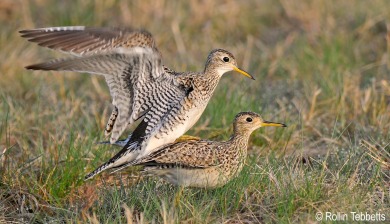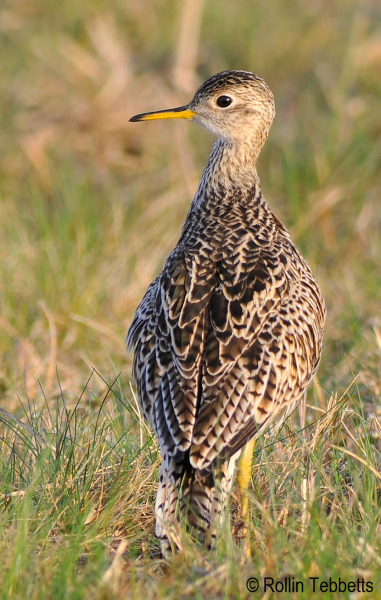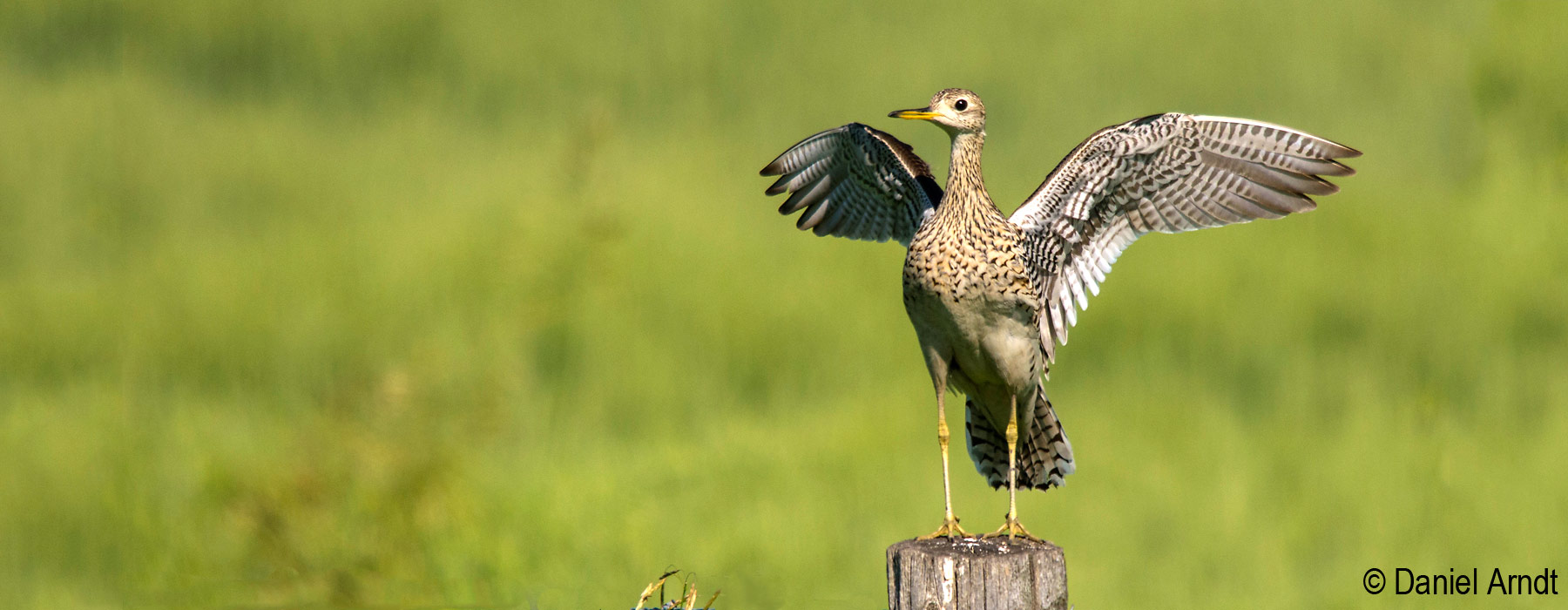Graceful and unusual, the Upland Sandpiper has been fondly described as a “pinhead.” Its moderate-sized body and long neck would seem to require a bird with a larger head. But that’s not this sandpiper’s only oddity. On its grassland breeding grounds, the Upland Sandpiper lets out a classic human “wolf-whistle.”
Although Upland Sandpiper populations are now relatively stable, they remain far below levels from before the rise of American row crop agriculture. VCE’s work is designed in part to maintain or boost the world population of this spectacular grassland species.
 From Alaska to Maine, Upland Sandpipers migrate at least 10,000 km each year to South America. Based on observational records, we know generally where they winter, and some of the habitats they use. We know that many of them migrate through Central America, fewer through the Caribbean, again based on scattered observations and museum records.
From Alaska to Maine, Upland Sandpipers migrate at least 10,000 km each year to South America. Based on observational records, we know generally where they winter, and some of the habitats they use. We know that many of them migrate through Central America, fewer through the Caribbean, again based on scattered observations and museum records.
To address threats that Upland Sandpipers face during the non-breeding season, we need to know more. Do different breeding populations winter in different regions? Do Upland Sandpipers move around during the winter? What habitats do they prefer during migration and in winter? Are they funneling through certain migratory corridors, are they concentrating at certain stopovers? Do they even have stopovers? How many and where?
VCE is attempting to answer these and other questions using the cutting-edge technology of geolocators. In partnership with the Department of Defense Legacy Program, VCE deployed satellite geolocators on Upland Sandpipers at four sites across the U.S. breeding range to obtain daily locations throughout the year. Satellite transmitters will provide accurate, daily location data directly downloaded from satellites, without retrapping the bird.
Natural History
 Upland Sandpiper populations are generally stable today, but are greatly diminished compared to the days before intensive row crop agriculture. Hunting and especially conversion of pastured land to crops dramatically reduced populations by the early 1900s. They have since declined further, but in recent decades have stabilized, except in the eastern portion of its range.
Upland Sandpiper populations are generally stable today, but are greatly diminished compared to the days before intensive row crop agriculture. Hunting and especially conversion of pastured land to crops dramatically reduced populations by the early 1900s. They have since declined further, but in recent decades have stabilized, except in the eastern portion of its range.
Upland Sandpipers need large open areas to breed, with a mosaic of different grassland habitat structures: shorter grasses for foraging, medium height grasses for protection of their precocial chicks, and taller grasslands for nesting. Upland Sandpipers are loosely colonial, with communal foraging and brooding areas, and can even nest within a few meters of each other. Territorial interactions between males are reserved for protecting females rather than a nest site or home territory. A voracious consumer of invertebrates year-round, Upland Sandpipers are a symbiotic friend to agricultural producers.
Cool “Pinhead” Facts
- In the Central Andes of Ecuador, 3,000 meters above sea level, thousands of Upland Sandpipers are found dead each year in September in lagoons, exhausted from migration and unable to cope with harsh weather events. Locals collect the birds, which they view as a gift from the gods.
- In the late 1800’s and early 1900’s, Upland Sandpipers and their eggs were intensively hunted for food in North America. For example, during the late 1870s and 1880s, 50,000–60,000 Upland Sandpipers were shipped to markets each year just from Nebraska alone. Although the Migratory Bird Treaty Act, passed in 1918, came too late for the now extinct Passenger Pigeon, it provided critical and successful protection for the Upland Sandpiper and many other overexploited bird species.
Conservation Action
Restoring and protecting large open grasslands in North America will ensure conservation of Upland Sandpiper habitat. Policies and market forces that incentivize landowners to convert grasslands to crops, especially in the core breeding range in the Prairie Potholes of the Great Plains, likely present the greatest threats to Upland Sandpipers. As populations in the eastern US continue to dwindle, conserving and appropriately managing remaining large open grassland areas such as airports and military bases will be critical to preventing extirpation.

